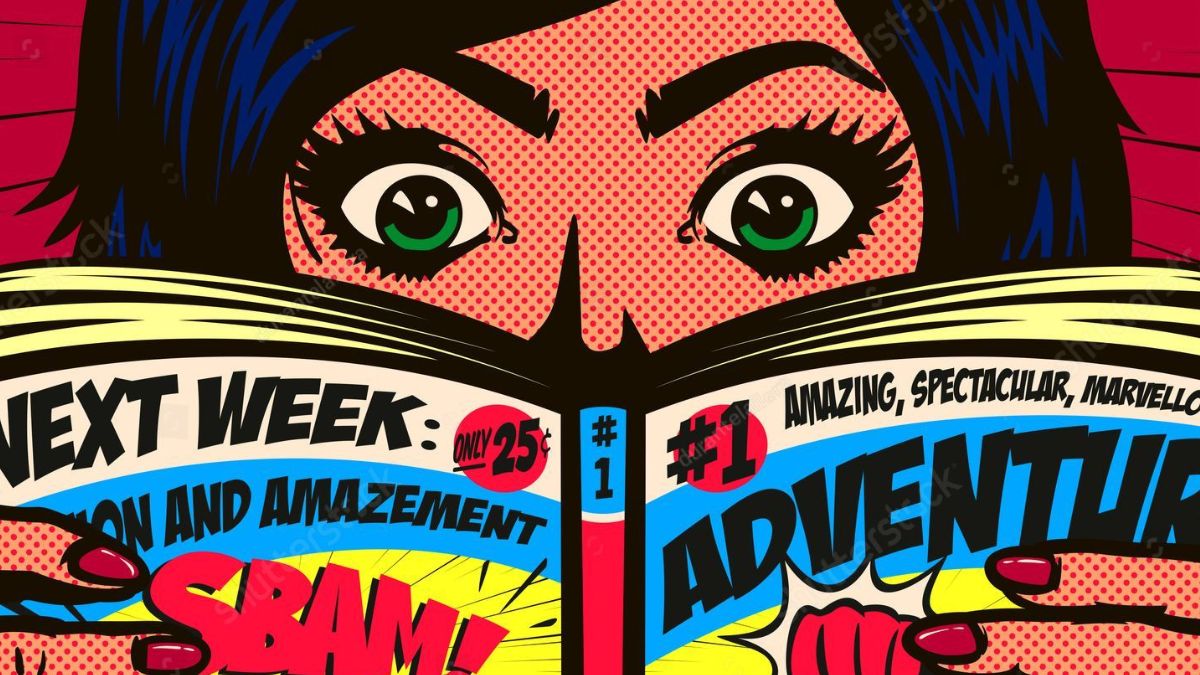EDUCATION
The Art and Craft of Creating Comic Books

A Brief History of Comic Books
Comic books have been a vibrant part of popular culture for nearly a century, capturing the imaginations of readers, young and old. Initially focused on superhero tales, they now encompass various genres, from science fiction to autobiographical stories. The evolution of comic books is as fascinating as the stories, tracing their growth from newspaper strips to a significant form of artistic expression. For those interested in sharing their stories and artworks, services offering comic book printing have made it easier for creators to bring their visions to life.
The first comic books appeared in the early 1930s, with characters like Superman and Batman becoming cultural icons. These early years set the stage for an explosion of creativity, leading to the Golden Age of Comics. The medium has undergone numerous transformations throughout the decades, adapting to social changes and technological advancements. The Golden Age, which spanned the late 1930s to the early 1950s, introduced many new characters and stories that captivated an audience hungry for escapism during tumultuous times.
Storytelling Techniques in Comic Books
Good storytelling is at the heart of every memorable comic book. Writers employ unique techniques such as episodic plots, cliffhangers, and multi-issue story arcs to keep readers eagerly anticipating the next issue. Compelling storytelling in comics also involves balancing concise dialogues with visual narratives, ensuring that both elements complement each other without overshadowing the other.
A well-crafted storyline engages readers by immersing them in the world of the characters, often dealing with complex themes and emotional depth. For example, the character arcs of superheroes usually tackle issues of identity, morality, and redemption. This makes the storytelling more than just about the battles between good and evil; it’s about the internal struggles that are universally relatable.
The Role of Illustration in Comic Books
Illustrations are more than just drawings of characters; they set the story’s mood, pace, and style. Comic book artists employ many techniques to bring the script to life, from detailed character designs to dynamic action sequences. The artistry involved in comic books requires both technical skill and creative vision.
Panels and layouts play a crucial role in guiding the reader through the story, with the arrangement of images and text creating a rhythm that enhances the narrative. Color schemes, shading, and intricate backgrounds contribute to each scene’s emotional and visual impact. For instance, darker tones may signify a tense or ominous atmosphere, while bright, vivid colors might highlight moments of joy or action.
Transitioning from Traditional to Digital Media
With the advent of technology, many comic book creators are now embracing digital media. Digital tools offer new possibilities, including enhanced colors, special effects, and interactive features. Decreased production costs and broader distribution channels are other advantages that digital media brings to the world of comics.
While traditional print remains beloved by many, integrating digital tools has democratized the creation and sharing of comic books—platforms allowing for easy sharing and collaboration and opening new opportunities for established and emerging artists. Digital platforms offer instant access to an international audience, breaking geographical barriers and allowing creators to build a global fanbase.
Comic Book Collecting and Its Significance
Collecting comic books is not just a hobby but a rich and significant part of art and culture. Rare editions and first prints can fetch high prices at auctions, making it an intriguing investment for enthusiasts. For devotees, the thrill of collecting lies in discovering hard-to-find issues and preserving pieces of comic book history. The community aspect of comic book collecting also adds to its appeal. Conventions, online forums, and local comic book shops allow fans to share their passion, discuss favorite issues, and trade or sell their collections. This communal aspect enhances the collecting experience, offering a sense of belonging and shared interest.
The Influence of Comic Books on Modern Media
Comic books have made a lasting impact on contemporary media, influencing blockbuster movies and popular video games. Franchises like Marvel and DC have expanded beyond the pages of comic books to dominate the box office and television screens worldwide. They have shaped much of today’s popular culture, influencing various forms of entertainment.
Comics’ storytelling and visual style have inspired countless creators in other media, resulting in adaptations that stay true to the original works while reaching new audiences. The success of comic book adaptations highlights the enduring appeal of these narratives. Television series and animated shows based on comics have also enjoyed widespread success, showcasing the versatility and broad appeal of comic book stories.
Steps to Create Your Comic Book
- Idea Generation: Generate ideas and select a central concept for your story. Consider what sets your idea apart and how it will differentiate itself in a competitive market.
- Script Writing: Write the script, paying close attention to dialogue and plot structure. Think about pacing and how each panel will flow into the next.
- Character Design: Sketch and develop your characters, considering their visual and narrative roles. Each character should have a distinct look and personality to make them memorable.
- Storyboarding: Create rough drafts of each page layout to guide the final illustrations. This step is crucial for planning scenes and ensuring a coherent visual flow.
- Final Art: Draw the final pages with detailed illustrations and inking, ensuring they are polished and professional. Pay attention to details like backgrounds and shading to enhance visual appeal.
- Editing: Review and refine the script and illustrations for coherence and appeal, making any necessary adjustments. Consider getting feedback from others to catch any overlooked issues.
- Publishing: Decide whether to publish traditionally or digitally, considering cost, reach, and personal preference. Each route has pros and cons; the best choice depends on your goals.
EDUCATION
How Personalized Tutoring Improves Writing Skills

Have you ever felt stuck, staring at a blank page, not knowing how to start your writing? Many students struggle with writing because they don’t receive enough personalized help.
In a busy classroom, teachers cannot always give each student the attention they need. Personalized tutoring can solve this problem. It focuses on your unique needs and helps you grow step by step.
This article will show you how tutoring can make writing easier, clearer, and more enjoyable for you.
Custom Feedback
Personalized tutoring gives students feedback based on their own work. The tutor points out the student’s strengths and weaknesses in writing. This helps students understand what they are doing right and what they need to correct.
The tutor explains mistakes in grammar, word choice, and sentence structure. They also help students understand how to organize their ideas. With this feedback, students can improve faster and avoid making the same mistakes again.
Tutors also track student progress over time. They adjust their advice as the student improves. This ongoing support promotes incremental growth for students.
Builds Confidence
When working with a tutor, students can ask questions in a safe space. They do not have to worry about judgment from others. This fosters a comfortable writing environment.
As students see their writing improve, their confidence grows. They become more willing to try new things in their writing. They gradually develop belief in their abilities.
A confident student writes more often. Practice helps them become stronger writers. With each success, their confidence continues to rise.
Focus on Weak Spots
Tutors identify students’ areas of struggle. This may include grammar, punctuation, or writing clear sentences. The tutor then creates lessons to fix these weak spots.
Students get to spend more time on the things they find hard. The tutor explains these topics in simple steps. With practice, students begin to improve in these areas.
Tutors provide examples illustrating what effective writing looks like. They go over each mistake until the student understands. This focus helps students overcome their weak spots.
Practice and Guidance
Tutors give students writing exercises that match their skill level. These exercises help students practice what they have learned. Every task is crafted to cultivate a specific writing skill.
The tutor guides students through each step of the task. They explain why each step matters. This helps students understand how to improve their writing.
Regular practice with a tutor ensures students stay on track. The more they practice, the more their writing improves. Guidance ensures they do not feel lost.
Better Organization
Tutors teach students how to plan their writing before they start. They show students how to organize ideas in a clear order. This makes the writing easier to read and understand.
Through practice, students master the creation of outlines. These outlines help students stay focused on the main topic. Good organization helps students write stronger paragraphs and essays.
Tutors also show students how to connect ideas. This makes essays flow better. Organized writing is easier for readers to follow.
Builds Good Habits
Regular tutoring helps students build good writing habits. Students learn to check their work for errors before submitting. This polishes and clarifies their writing.
Tutors remind students to revise and edit their work. Over time, students start doing this on their own. These habits help students become better writers in school and beyond.
For students who struggle with staying consistent, extra support can be helpful. If you want steady progress and personal guidance, consider a 1-on-1 academic writing coach.
Expands Vocabulary
Tutors assist students in learning new words to use in their writing. They explain the meaning and proper use of each word. This enriches student writing and enhances clarity.
With a bigger vocabulary, students can express ideas better. They are able to choose words that fit their message. This makes their writing stronger.
Tutors also help students avoid using the same words too often. They teach students how to vary their word choice. This keeps writing fresh and interesting.
Improves Grammar Skills
Grammar is a key part of writing. Tutors teach students the rules of grammar step by step. This helps students avoid common mistakes.
Students learn how to use correct tenses, punctuation, and sentence structures. The tutor explains why each rule matters. This makes students more careful with their writing.
With time, students start to spot their own grammar mistakes. They become more independent writers. Proper grammar makes their writing easier to comprehend.
Develops Critical Thinking
Writing well means thinking clearly. Tutors teach students how to build strong arguments and support their ideas. This helps students think in a more organized way.
Critical thinking skills help students explain their points better. Tutors ask questions that make students think deeper. This improves the quality of their writing.
Students gain the ability to consider multiple perspectives on a topic. This makes their writing more balanced. Critical thinking skills are invaluable both in academic settings and daily life.
Encourages Creative Expression
Tutors encourage students to share their own ideas. They help students feel safe to express themselves in writing. This makes writing more personal and meaningful.
Creative writing exercises are often used in tutoring sessions. These activities help students develop their unique voice. The tutor guides students to keep their writing clear and focused.
By expressing their thoughts freely, students enjoy writing more. This leads to more practice and improvement. Creativity makes writing more engaging.
Teaches Editing Skills
Editing is an important part of writing. Tutors show students how to review and improve their own work. They teach students to look for errors and unclear sentences.
Students learn how to cut unnecessary words. They also learn how to add details that improve their message. This makes their writing stronger and more clear.
Tutors help students understand that editing takes time. With practice, students become better at spotting mistakes. Editing skills are useful for all kinds of writing.
Unlock Your Best Writing Self With a Tutor Who Gets You
Good writing is not about being perfect from the start. It is about learning, practicing, and getting the right help along the way. Personalized tutoring gives you a safe space to grow and improve at your own pace.
With time and support, anyone can become a better writer. All it takes is guidance that speaks to you and practice that builds your confidence.
Did you learn something new from this article? If so, be sure to check out our blog for more educational content.
EDUCATION
Jonathonspire: The Go-To Blog for Digital Marketing and Tech Insights

When it comes to staying competitive in the fast-moving world of digital marketing and technology, knowledge is power. Whether you’re a seasoned marketer, an entrepreneur looking to scale your business, or a tech enthusiast eager to stay updated on the latest trends, having a reliable source of information is key. That’s where Jonathonspire comes in.
This blog has become a trusted name for practical tips, expert advice, and in-depth insights into marketing and technology. With a mix of meticulous research, real-world examples, and forward-thinking perspectives, Jonathonspire is helping businesses and individuals alike make informed decisions.
Why Trust Jonathonspire?
Jonathonspire stands out in the crowded landscape of blogs for several reasons.
- Expertise You Can Count On
Jonathonspire offers expertise in areas like social media marketing, content creation, SEO strategies, tech reviews, and much more. Articles are written with clarity and context, meaning you’ll leave with actionable insights rather than vague advice.
- Wide Range of Topics
From navigating the complexities of digital advertising to uncovering the best tools for social growth, Jonathonspire covers it all. The blog’s versatility ensures there’s something valuable for everyone.
- Focus on Practical Value
Every article is designed to address real challenges in the marketing and tech space. You won’t be scrolling through pages of filler content; instead, expect detailed solutions and actionable takeaways to guide your next steps.
Below, we’ll break down what makes Jonathonspire’s blog such a critical resource for anyone in marketing and tech spaces.
Digital Marketing Mastery
Digital marketing has never been more essential, but it’s also more complex than ever. From SEO to social media advertising, there’s a lot to keep track of. Jonathonspire tackles this complexity head-on with comprehensive guides that bring clarity to every marketer’s toolbox.
Staying Ahead in SEO
Search engine optimization (SEO) remains critical for driving organic traffic, but algorithms keep evolving. Jonathonspire dives deep into SEO strategies that align with the latest Google updates. Popular posts include step-by-step guidelines, from keyword research and on-page optimization to building backlinks without penalties.
Example:
One must-read guide covers the best tools for SEO, highlighting both free and premium platforms for everything from analytics to optimization. For small businesses looking to maximize ROI, this kind of targeted advice is invaluable.
Unlocking Social Media Marketing Success
Social media is a crowded space, and marketers need to think strategically to stand out. That’s why articles exploring platforms like Instagram, Facebook, TikTok, and LinkedIn are so helpful.
Jonathonspire doesn’t just focus on trends; it explains how to take advantage of them. Want to learn how to run an effective Facebook ad campaign? Or how to leverage Instagram reels for better engagement? The blog’s unique insights break down such actions into manageable steps.
Pro Tip from Jonathonspire:
Use personalization to connect with your audience better. Social media platforms reward authentic, user-focused interactions, and Jonathonspire explains how to blend data with creativity to achieve this.
Cutting-Edge Tech Insights
Beyond marketing, Jonathonspire has a passion for tech innovation. The blog examines tools, platforms, and software solutions that shape the digital landscape.
Honest Software Reviews
Not all tools are created equal, and Jonathonspire’s in-depth reviews provide clarity. Whether you want information on email marketing software, influencer marketing tools, or automation platforms, you’ll find transparent reviews that outline both the pros and cons.
For businesses hesitant to invest in new tech, this level of honesty ensures informed decisions. One of the most highly regarded posts compares popular social media growth services, helping users find ethical, effective platforms that deliver real results.
The Future of Technology
Jonathonspire doesn’t stop at the present; it also keeps its readers future-ready. Posts often explore emerging trends like artificial intelligence, voice search compatibility, blockchain technology, and predictive analytics. With these insights, businesses can anticipate industry shifts and stay ahead of the competition.
Building Communities, One Insight at a Time
One of Jonathonspire’s most compelling features is the community it fosters. It’s not just a blog; it’s a hub where marketers, entrepreneurs, and tech enthusiasts share ideas, exchange knowledge, and collaborate.
Engaging Discussions
Every post ends with thought-provoking questions that encourage readers to share their own experiences and tips. Unlike other blogs where interaction is passive, Jonathonspire thrives on its active and engaged audience.
Newsletters and Updates
For those who want curated content directly in their inbox, Jonathonspire offers a newsletter packed with value. Subscribers get first access to new articles, exclusive tips, and personalized recommendations based on industry trends.
Actionable Advice for All
Whether you’re just starting your digital marketing career or you’re looking to refine your organizational tech stack, Jonathonspire delivers relevant advice. Its content consistently guides professionals on how to improve performance, save time, and boost their results.
Some of the blog’s standout resources include:
- Marketing strategies for small businesses: Learn how to maximize your budget while getting measurable results.
- Content creation tips: Discover how to write compelling articles, craft engaging videos, and tell your brand story effectively.
- Data tools for success: Find out how leveraging analytics can lead to smarter marketing decisions.
Start Leveraging Jonathonspire Today
Your business and career are too important to rely on guesswork, and staying ahead requires continuous learning. Jonathonspire equips readers with a roadmap to succeed in the dynamic worlds of digital marketing and technology.
Are you ready to unlock your potential? Head over to Jonathonspire’s blog and discover the difference knowledge can make.
EDUCATION
Naviance: A Guide to College and Career Readiness

Navigating the pathway from high school to college or directly into a fulfilling career can feel overwhelming. Students and parents alike often face questions about how to make informed decisions about future opportunities. Thankfully, tools like Naviance have been designed to guide students through this critical juncture in their lives.
This blog will help you explore Naviance, a platform known for helping students plan their academic paths, prepare for college applications, and even discover viable career options. By the end of this guide, you’ll understand how Naviance works, its key features, and how it strengthens students’ readiness for a bright future.
What is Naviance?
Naviance is an education-focused platform that empowers middle and high school students to make informed decisions about their academic and career futures. Schools nationwide rely on Naviance to offer tailored guidance for student success.
From creating a personalized learning plan and exploring colleges to identifying career strengths, Naviance provides an all-in-one solution to help students develop their academic and professional roadmaps.
Notable tools on Naviance include career planning resources, college research tools, application tracking, and self-discovery assessments, all of which guide students in understanding their unique strengths, goals, and potential.
Key Features of Naviance
1. Self-Discovery Assessments
One of Naviance’s standout features is its comprehensive self-discovery tools. These assessments help students identify their skills, strengths, and interests, laying a solid foundation for choosing a college major or career field.
- StrengthsExplorer evaluates individual talents and provides actionable advice for personal growth.
- Career Interest Profiler identifies career areas that align with a student’s interests.
- Learning Style Inventory helps students understand how they learn best, enabling them to optimize their study habits.
By learning more about themselves, students can make decisions that resonate with who they truly are.
2. Comprehensive College Research Tools
Finding the right college is no easy task, but Naviance simplifies this process by offering a suite of tools to streamline college research.
- College Match enables students to compare schools based on their academic interests, size, location, and other preferences.
- Naviance also provides data on former students from a school to highlight trends like acceptance rates, average GPA, and standardized test scores, helping users gauge their chances at various institutions.
- The Scholarship Search tool connects students to financial aid opportunities that fit their profile.
By offering data-backed insights, Naviance takes the guesswork out of college planning.
3. Career Exploration
Beyond college applications, Naviance emphasizes post-graduation goals with its career exploration section. Using data from leading workforce insights, Naviance guides students toward meaningful career paths.
- Career Key connects students with potential job roles based on their values, skills, and interests.
- Students can also explore educational requirements and average salaries for roles they’re interested in, providing a realistic view of life after school.
With these resources, students gain clarity on how their education can translate into meaningful career opportunities.
4. Application Tracking and Planning
Naviance simplifies college applications by allowing students to track submissions and meet key deadlines. Its integrated tools help set clear goals and provide reminders for essentials like essay submissions and recommendation letter requests.
Features like the Naviance eDocs streamline the application process for both students and school administrators, ensuring no document is left behind. This makes the stressful college application season much more manageable.
5. Collaboration and Support
Success is rarely achieved alone, which is why Naviance prioritizes collaboration.
- Students can connect with teachers and counselors directly through the platform.
- Parents also play a vital role in the process and are given access to tools so they can follow their child’s academic and career progress.
This ecosystem of support ensures that students never face this challenging period alone.
How Naviance Helps Schools and Educators
While Naviance is undoubtedly student-focused, schools and educators benefit significantly from its implementation as well. The platform offers data-driven insights into student performance, helping educational institutions identify trends and provide targeted support where it’s needed most.
Every year, high schools across America use Naviance to monitor metrics like graduation rates, college readiness, and student engagement. This data not only supports administrative goals but also fosters tailored instruction for each student’s unique needs.
Tips for Getting the Most Out of Naviance
While Naviance equips students with plenty of tools, maximizing these features ensures the best results. Here are some best practices for leveraging the platform effectively:
- Start Early
Don’t wait until senior year to explore Naviance. The earlier students start, the more time they have to make well-informed decisions about their academic and career paths.
- Set Clear Goals
Whether it’s identifying a dream college, creating a resume, or learning about potential careers, defining goals within the platform helps students stay focused and motivated.
- Engage with Counselors
Schedule regular meetings with school counselors to go over Naviance data and ensure it aligns with your broader educational plan.
- Track Progress
Use Naviance’s progress-tracking tools frequently to ensure deadlines, milestones, and submissions are on track.
- Use Resource Libraries
Naviance offers access to guides, videos, and checklists. These resources are invaluable for navigating financial aid, standardized testing, and more.
The Big Picture
Naviance is more than just a tool; it’s a roadmap that helps students discover who they are, where they want to go, and how to get there. Whether you’re a parent supporting your child’s future, an educator guiding students toward success, or a student determining your next step, Naviance offers clarity and direction during a pivotal time in life.
If you’re new to Naviance or looking to explore its features in greater depth, now’s the perfect time to log in and get started. With the right guidance and effort, achieving your college and career goals is closer than you think.
-

 HEALTH1 year ago
HEALTH1 year agoIntegrating Semaglutide into Your Weight Loss Plan: A Practical Guide
-

 HOME IMPROVEMENT1 year ago
HOME IMPROVEMENT1 year agoHow to Choose the Perfect Neutral Area Rug for Every Room
-

 LAW1 year ago
LAW1 year agoPost-Divorce Considerations in California: Modifications and Long-Term Planning
-

 LAW1 year ago
LAW1 year agoTeenage Drivers and Car Accidents in California: Risks and Parental Liability
-

 CONSTRUCTION1 year ago
CONSTRUCTION1 year agoConstruction Site Safety Regulations in New York and Your Rights as a Worker
-

 FINANCE1 year ago
FINANCE1 year agoDigital Asset Management in Florida Estate Planning
-

 LAW1 year ago
LAW1 year agoKentucky’s School Football: Concussions, Injuries, and Legal Options
-

 LAW1 year ago
LAW1 year agoGang Activity and Criminal Charges in CA: Protecting Your Rights
